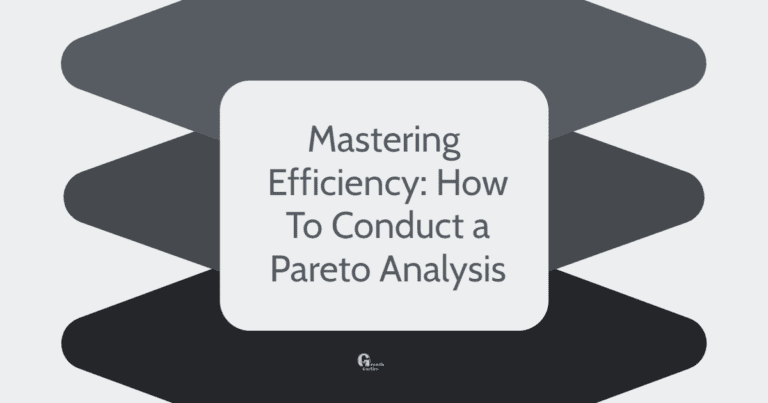In today’s fast-paced world, maximizing productivity has become a top priority for individuals and organizations alike. We are constantly seeking ways to streamline our efforts, eliminate inefficiencies, and make the most of our limited resources. One technique that has gained significant attention in the productivity realm is the Pareto Analysis, also known as the 80/20 rule.
Jump To Section
Understanding the Pareto Principle
Before we dive into the details of Pareto Analysis, let’s take a moment to understand the concept and its origins. Named after Italian economist Vilfredo Pareto, the Pareto Principle, commonly known as the 80/20 rule, states that approximately 80% of the outcomes are a result of 20% of the inputs or causes. This principle can be applied to several areas of life, including productivity.
For example, in business, it is often found that 80% of a company’s profits come from 20% of its clients. Similarly, in personal time management, 80% of our results come from 20 percent of our efforts. Understanding and leveraging this principle can be incredibly valuable in boosting productivity.
Identifying the Area of Focus
The first step in conducting a Pareto Analysis is to identify the specific goal or problem that you want to address. It could be a project with numerous tasks, a business process causing bottlenecks, or even personal time management issues. Once you have identified the area to focus on, you can move on to the next step.
Next, assess the different areas that are affected by the identified goal or problem. For example, if you are looking to improve productivity in a business process, consider all the stages and factors involved. This could include technology, human resources, communication, or any other relevant areas. By gaining a holistic understanding of the situation, you can accurately pinpoint the areas that have the most significant impact on productivity.
Finally, prioritize the areas you have identified based on their potential impact. Focus on those areas that, if improved, would produce the most substantial results. These are the areas where the Pareto Principle can be effectively applied, as they have the potential to yield the greatest returns with minimal effort.
Unleash your true potential by harnessing the power of the 80/20 rule. Boost your productivity and transform your life! Check out this mind-blowing blog post: #ParetoAnalysis #ProductivityBoost
Gathering Data
Once you have identified the area to focus on and prioritized the relevant factors, it’s time to gather the necessary data. Look for relevant data sources that can provide insights into the identified areas. This could include sales reports, time-tracking tools, customer feedback, or any other data that can shed light on the situation.
Sort and organize the data into manageable categories. This step is crucial to ensure that you are working with structured and easily accessible information. Depending on the nature of the data, you may find it helpful to create graphs, tables, or other visual representations that make the analysis process more efficient.

Performing Pareto Analysis
With the data organized, it’s time to perform the actual Pareto Analysis. One useful tool for this purpose is the Pareto chart. A Pareto chart visually represents the frequency or impact of different factors, allowing you to identify the significant contributors more easily.
Plot the data on a Pareto chart, arranging the factors in descending order based on their frequency or impact. This will help you visualize which factors are the most significant and warrant immediate attention.
Now comes the analysis part. Examine the Pareto chart to identify the vital few factors that contribute the most to the identified goal or problem. These are the 20% of inputs or causes that have an 80% impact. By focusing your efforts on these vital few factors, you can make the most efficient use of your resources and achieve significant productivity improvements.
Developing an Action Plan
Armed with the knowledge of the vital few factors, it’s time to develop an action plan. Formulate strategies that prioritize and address these factors head-on. Depending on the nature of the factors, this could involve implementing specific changes, investing in additional resources, or reallocating existing resources for maximum impact.
Implement the identified corrective measures and closely monitor and track progress. This will help you evaluate the effectiveness of the action plan and make any necessary adjustments along the way. By regularly reviewing and measuring your progress, you can ensure that your efforts are on track and that you are continuously improving productivity.
Applying Pareto Analysis for Personal Productivity
The Pareto Analysis is not limited to business or organizational settings; it can be equally effective in personal time management. Consider identifying personal time-wasting habits and analyzing how often these habits occur and their impact on productivity.
For instance, if you find that excessive time spent scrolling social media is one of your major time-wasters, you can develop strategies to cut back on this habit. By targeting the vital few time-wasters, you can reclaim valuable hours in your day and focus on activities that contribute to your overall goals and productivity.
Applying Pareto Analysis in Business
In a business context, Pareto Analysis can be instrumental in pinpointing inefficiencies in workflows or processes. By identifying the vital few factors causing delays or bottlenecks, you can make targeted improvements, resulting in enhanced overall productivity and efficiency.
For example, if you notice that a particular stage in your project management process consistently delays progress, you may want to investigate and address the root causes behind it. This could involve implementing software solutions, providing additional training, or reorganizing responsibilities to minimize the impact of these bottlenecks.
Steps to Create a Pareto Chart
Creating a Pareto chart may seem daunting at first, but fear not! Follow these simple steps, and you’ll be a Pareto chart pro in no time.
1. Identify the problem or process to be analyzed
Begin by clearly defining the problem or process you want to address. This step sets the foundation for your Pareto chart and ensures you stay focused on the objectives.
2. Collect and organize relevant data for analysis
Next, gather the necessary data to understand the problem better. This data should be factual, accurate, and relevant to the specific issue at hand. Organize the information in a way that is easily accessible for analysis.
3. Calculate the frequency or occurrence of each factor
In this step, determine the frequency or occurrence of each factor contributing to the problem. Focus on quantifiable data to ensure objective analysis. This information will be used to establish the basis of your Pareto chart.
4. Sort the factors in descending order of significance
Once you have the frequency data, sort the factors in descending order based on their significance. The most significant factor should be at the top, while the least significant should be at the bottom. This arrangement enables you to prioritize your efforts effectively.
5. Generate a bar chart to visually represent the Pareto chart
With the sorted data in hand, it’s time to create your Pareto chart. One of the most common ways to represent this chart is through a bar graph. The height of each bar corresponds to the frequency or occurrence of each factor, while the bars are arranged in descending order.
6. Add cumulative percentages for effective analysis
Enhance your Pareto chart by including cumulative percentages. These percentages represent the total contribution of each factor to the overall problem. They allow for a clearer understanding of the combined impact of the top few factors.

Tips for Effective Use of Pareto Charts
Now that you know how to create a Pareto chart, here are some essential tips for getting the most out of this powerful tool:
First, choose a clear and concise title for your chart. This title should accurately reflect the problem or process you’re addressing, making it easier to communicate and understand.
Next, use appropriate labels for the axes of your chart. Clearly indicate what each axis represents to provide context and ensure the chart is easily interpreted.
Accurate data collection and calculation are vital for a reliable Pareto chart. Double-check your data sources and calculations to ensure the chart’s integrity and validity.
Regularly update and reassess your Pareto chart as you gather new data or address specific factors. This will keep your analysis current and help you stay on top of any changes or improvements.
Finally, communicate your findings and motivate change using the Pareto chart. Use it as a visual aid to demonstrate the significance of the problem and the need for action, inspiring others to join the efforts for improvement.
Understanding the Obstacles in Pareto Analysis
Lack of data accuracy and completeness
One common obstacle in Pareto Analysis is the lack of accurate and complete data. Without reliable data, it becomes challenging to identify the key issues and prioritize them effectively. To overcome this obstacle, it is crucial to establish data collection protocols and ensure that all data sources are trustworthy and up-to-date. By investing in data management tools and techniques, organizations can streamline the process of data collection, verification, and analysis, enabling more accurate Pareto Analysis results.
Difficulty in categorizing and prioritizing issues
Categorizing and prioritizing issues can be a daunting task, especially when there are multiple factors to consider. To overcome this obstacle, it is essential to establish clear criteria for categorization. By defining specific categories and guidelines, organizations can ensure consistency and accuracy in the classification of issues. Additionally, developing a framework for priority setting helps in identifying the most critical problems that require immediate attention. By involving cross-functional teams in this process, a broader perspective can be gained, leading to better categorization and prioritization.
Resistance to change and fear of accountability
Resistance to change and fear of accountability are common obstacles that can hinder the successful implementation of Pareto Analysis. Some employees may feel uncomfortable with the idea of change, fearing that it might expose their weaknesses or lead to increased scrutiny. Overcoming this obstacle requires creating an environment of employee engagement and buy-in. By involving employees in the problem-solving process and clearly communicating the benefits of Pareto Analysis, organizations can alleviate fears and foster a culture of continuous improvement. Providing necessary training and resources for skill development further encourages employees to embrace change and be accountable for their actions.
Strategies to Overcome Obstacles
To overcome the obstacle of data accuracy and completeness, organizations should implement data collection protocols. These protocols should define the methods, tools, and frequency of data collection, ensuring consistency and reliability. Additionally, investing in data management tools can streamline the process and provide real-time access to accurate and complete data. By prioritizing data quality, organizations can enhance their Pareto Analysis results and make informed decisions.
Enhancing categorization and prioritization processes
Establishing clear guidelines for categorization is key to overcoming this obstacle. By defining specific criteria for each category, organizations can eliminate ambiguity and ensure consistent classification of issues. Furthermore, engaging cross-functional teams in the categorization process brings different perspectives and expertise, leading to a more comprehensive understanding of the problems at hand. By prioritizing issues based on their impact and urgency, organizations can effectively allocate their resources and address critical areas first.
Fostering a culture of accountability and change
To overcome resistance to change and fear of accountability, organizations need to create a supportive environment. This can be achieved by providing employees with the necessary training and resources to develop the skills required for successful problem-solving and decision-making. Recognizing and rewarding successful outcomes reinforces the importance of taking ownership and being accountable for the results. By nurturing a culture that values continuous improvement, organizations can overcome this obstacle and fully leverage the power of Pareto Analysis.
Case Studies: Real-World Examples of Overcoming Obstacles
Case Study 1: Improving Customer Satisfaction Ratings
In our first captivating case study, we encounter a company grappling with persistently low customer satisfaction ratings. Frustration rippled through the organization as they were left puzzled by the root causes behind the dissatisfaction. Thankfully, Pareto Analysis came to the rescue!
Through careful examination of customer feedback and data, the team applied Pareto Analysis to identify the main drivers of discontent. They discovered that a small fraction of issues, such as prolonged response times and incorrect product shipments, were responsible for a significant portion of the negative feedback.
Empowered with this knowledge, the company equipped itself with actionable insights to tackle the problem head-on. They prioritized addressing these vital factors by implementing measures like streamlining customer service processes, enhancing training programs, and optimizing order fulfillment procedures.
Fast forward a few months, and the results spoke for themselves. Thanks to the targeted interventions guided by Pareto Analysis, customer satisfaction ratings soared, transforming disgruntled customers into loyal brand advocates.
Case Study 2: Reducing Production Line Defects
Our next thrilling case study takes us to a bustling manufacturing company plagued by a high volume of defects in their production line. The impact of these defects was detrimental, resulting in wasted resources, customer complaints, and decreased profitability. Frustrated by the mounting losses, the company turned to Pareto Analysis for a lifeline.
The diligent team meticulously audited their production line, collecting data on potential causes of defects. Armed with this data, they employed Pareto Analysis to identify the critical few factors triggering the majority of the defects. Surprisingly, they discovered that a handful of issues, such as machine calibration errors and inadequate quality control processes, were at the root of their woes.
Energized by these revelations, the company engineered specific actions to address these key problem areas. They recalibrated machinery, implemented advanced quality control measures, and invested in comprehensive training programs for their workforce.
The results were astounding. Production line defects dwindled, leading to fewer customer complaints, improved product quality, and increased profitability. Pareto Analysis had once again proven its extraordinary ability to create impactful change.
Case Study 3: Optimizing Inventory Management
In this final riveting case study, we venture into the retail industry, where a company faced challenges with excessive inventory levels and frequent stockouts. Prodigiously, they sought guidance from the ever-reliable Pareto Analysis to regain control over their inventory management.
With determination, the company gathered a trove of data relating to its inventory imbalances. Armed with this information, they employed Pareto Analysis to discern the most influential factors contributing to the issue. To their astonishment, they discovered that a small portion of their products accounted for the majority of their stockouts and excess inventory.
With clarity in sight, the company set forth to tackle these vital few factors. They implemented strategies such as demand forecasting, inventory optimization algorithms, and strategic vendor partnerships to address the root causes of their inventory management challenges.
The outcomes were remarkable. The company experienced a substantial reduction in stockouts, resulting in improved customer satisfaction and increased profitability. Furthermore, their excess inventory diminished, leading to reduced storage costs and improved cash flow. Pareto Analysis had yet again proven its potency in unlocking efficiency and profitability.
Conclusion
By incorporating the Pareto Analysis into our lives, both personally and professionally, we can achieve enhanced productivity by focusing our efforts on the vital few factors that yield the greatest results. Understanding and leveraging the power of the Pareto Principle allows us to streamline our activities, eliminate inefficiencies, and make the most of our resources. Armed with this knowledge, we can make informed decisions, prioritize effectively, and ultimately boost our productivity, leading to improved outcomes in all areas of life.


